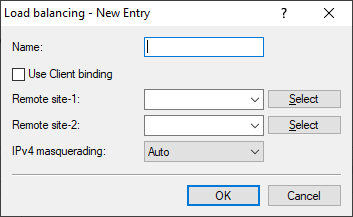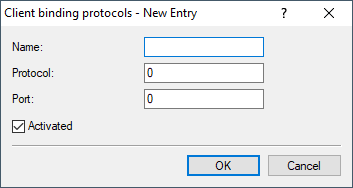To configure load balancing with LANconfig navigate to the view .

Activate load balancing with the item Load balancing enabled. Further settings are adjusted under Load balancing.

- Name
- Unique name for a virtual load-balancing remote site. This remote site can then be used in the routing table.
- Use client binding
- Activates or deactivates the client binding function.
- Peer-1
- Name of a previously configured remote site that is to be bound with others.
- Peer-2
- Name of a previously configured remote site that is to be bound with the first one.
- IPv4 masquerading
- This menu item contains the settings for IPv4 masquerading in the load balancer. Possible values:
- Automatic
- Adopts the masking option for each individual line from the routing table.
- On
- Activates NAT on all remote sites in the load balancer.
- No
- Deactivates NAT on all remote sites in the load balancer.
- Only intranet
- Activates NAT for networks of the type INTRANET. The DMZ will not be masked.
For each destination address, client binding can assign connections that correspond to certain protocol/port combinations to a fixed WAN connection. This avoids changing source addresses when using these connections. Client binding may be activated during load balancing.
- Binding minutes
- Here you specify the time in minutes for the binding entries to be valid for a client.
- Balance seconds
- To prevent data from flowing via the main-session Internet connection when it could easily be transferred via parallel connections, a timer ensures that the load balancer distributes additional sessions between the available Internet connections for a specified period. After the timer expires, the client binding forces a new session over the original Internet connection and the timer is restarted. The server thus continues to recognize the login status for the user due to the current IP address. Here you specify the time in seconds, following the start of the main session, during which the load balancer is free to distribute new sessions to other Internet connections.
Under Client binding protocols you configure the corresponding protocol/port combinations.

- Name
- Give this entry a name.
- Protocol
- Contains the IP protocol number. Learn more about IP protocol numbers in the IANA Online database.
- Port
- Contains the port of the IP protocol.
- Activated
- Activate this entry.
Note: For the following example configurations we assume that the remote devices are already set up with all necessary access information.
